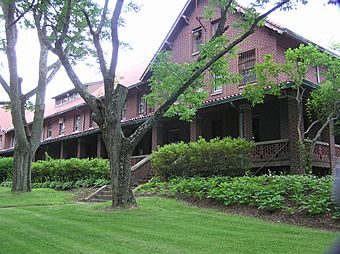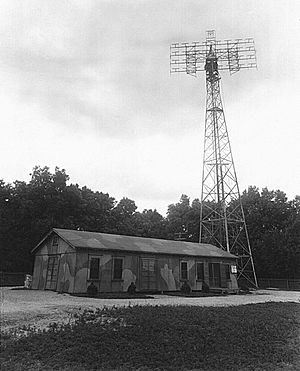Camp Evans Historic District facts for kids
|
Camp Evans Historic District
|
|

The Marconi Hotel dedicated in 1914 at the Belmar Receiving Station is now InfoAge's "main campus"
|
|
| Nearest city | Belmar, New Jersey |
|---|---|
| Area | 55 acres (22 ha) |
| Built | 1912–1914 |
| NRHP reference No. | 02000274 |
Quick facts for kids Significant dates |
|
| Added to NRHP | March 26, 2002 |
| Designated NHLD | October 16, 2012 |
The Camp Evans Historic District is a special area located in Wall Township, New Jersey. This site is well-known for its important role in the history of radio and electronics. It once housed a transatlantic radio receiver built in 1914. Later, during World War II and the Cold War, it became home to many important laboratories for the United States Army. These labs worked on things like radio signals, vacuum tubes, and even early photo-optics. In 2012, it was recognized as a National Historic Landmark District. This honor highlights its long and significant contributions to modern electronic communication for both everyday use and military purposes.
Contents
Marconi's Belmar Radio Station
The Belmar Receiving Station was built near Belmar, New Jersey. It worked with a separate transmitting station in New Brunswick, New Jersey. Both were created by the Marconi Wireless Telegraph Company of America. The Belmar station had a huge antenna system. It used a mile-long bronze wire held up by six tall masts. There were also three balancing towers along the Shark River.
Messages were sent using Morse code. They traveled from Belmar to the transmitter via a telegraph line. The receiving site also had a telegraph line to an office in New York City. Buildings for the Belmar station were constructed between 1912 and 1914. This was part of Guglielmo Marconi's plan for a worldwide wireless network. In one of these buildings, a new invention called the regenerative circuit was shown in early 1914.
In April 1917, the U.S. Navy took over the Belmar station for World War I communications. After the war ended in November 1918, American Marconi got the station back. Then, Radio Corporation of America owned it from 1919 until 1924.
Evans Signal Laboratory's Beginnings
In 1941, the Belmar radio site was renamed the Evans Signal Laboratory. This happened after Wall Township bought the original Marconi buildings and 93 acres of land. The Army needed this space to move its Signal Corps Radar Laboratory (SCRL) here.
Quickly, more than two dozen new buildings were constructed. These were built on the open land around the Marconi buildings. They included boiler houses, long rectangular buildings, and radio antenna shelters. Two models of the SCR-271 radar were also set up on the site. One of them had a sign for the SCRL Installation and Maintenance School.
Camp Evans: A Hub of Innovation
The site officially became Camp Evans on February 17, 1942. The Camp Evans Signal Laboratory was named on March 31, 1942. In December 1942, the War Department combined several labs into the Signal Corps Ground Service (SCGS). Camp Evans was a key part of this new group.
The lab at Camp Evans made many important advances. They developed special tubes to adapt radars for ships. They also improved the SCR-268 radar to detect Japanese kamikaze planes. They worked on the SCR-584 tracking radar, adding "identification friend or foe" technology. The lab also improved parts for things like the proximity fuse. They even had a special unit that tested captured German and Japanese radars.
Camp Evans also helped develop Army radars made by private companies. These included early warning radars and height finders. By August 1943, Lt Col Paul E. Watson was the director of the lab. Camp Evans also had the Joint Army-Navy Tube Standardization (JANS) Laboratory. By the end of World War II, Camp Evans had about 134 buildings on 217 acres.
Cold War Discoveries
After World War II, Camp Evans was the first stop for many top German scientists. They came to the U.S. as part of Operation Paperclip. This program brought scientists to help America's research efforts. For example, Dr. Walter McAfee at nearby Fort Monmouth helped calculate the moon's speed during Project Diana.
On January 10, 1946, during moonrise, Project Diana made history. Scientists at Camp Evans sent VHF radar pulses to the moon. They then detected the reflections using a modified SCR-271 radar. This was a huge step in space communication. By 1951, Camp Evans also had a Meteorological Branch to study weather.
In 1952, the Army Radiation Dosimetry Laboratory was built. It had thick walls and special equipment to study radiation safely. In 1957, equipment at the Project Diana site helped track Sputnik 1, the Soviet Union's first satellite. This showed Camp Evans' continued importance in space research.
Camp Evans became part of the Signal Radio Propagation Agency. It helped develop weather radars. The lab also became the U. S. Army Signal Corps Research and Development Laboratory. In 1960, the NASA TIROS-1 satellite sent the first photograph from space. The ground antenna for this was at the Project Diana site at Camp Evans. The Army Photo-optics Laboratory also opened here in 1963.
Camp Evans Closes
At the end of the Cold War, in 1993, Camp Evans was chosen for closure. Many units moved to nearby Fort Monmouth. The Army Radiation Dosimetry Laboratory closed in 1999. The land at Camp Evans was then transferred to the National Park Service.
Today, a part of the former camp is home to the Brookdale Campus at Wall. This is a branch of the Brookdale Community College. In 2002, a section of Camp Evans was listed on the National Register of Historic Places. It also became part of the Save America's Treasures project.
InfoAge Science Center
The InfoAge (Information Age Learning Center) is now located in some of the historic buildings at Camp Evans. InfoAge is a member of the Association of Science-Technology Centers. It also works with the NASA Digital Learning Network.
InfoAge focuses on science and the military history of Camp Evans. Visitors can explore many exhibits and organizations. These include displays on computers, electronic warfare, and vintage radio equipment. There's also the National Broadcasters Hall of Fame and Museum. The Computer Deconstruction Laboratory and the New Jersey Shipwreck Museum are also here.
ISEC, the InfoAge Science History Learning Center, offers exhibits and programs. They have lectures, activities, and summer programs for both adults and young people. Some exhibits include the Laser Interferometer, the Diana Site, and galleries showing the restoration of the TLM-18 antenna.



